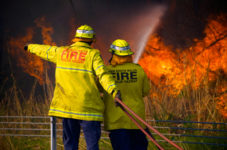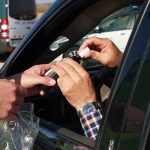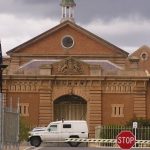The Crime of Arson in New South Wales

Two people are dead, several remain missing and more than 150 homes have been destroyed in the past several weeks as bushfires have surged out of control along the Eastern Coast of Australia.
With most of the country in severe drought, total fire bans are being enforced across every jurisdiction, but that doesn’t stop people from doing the wrong thing.
In far northern New South Wales over the weekend, two youths were arrested after allegedly setting a fire in scrubland at Kingscliff by gathering paper, dry leaves and vegetation and setting it alight with a cigarette lighter.
A man walking past saw the smoke, and the boys – who fled towards the beach. He tried to put the fire out himself before calling the fire brigade. Firefighters managed to put the fire out quickly, but the damage could have been much worse in the hot, dry conditions.
Police eventually caught two young teens who they believe started the fire. Aged 13 and 14, the boys have been dealt with under the Young Offenders Act.
A large percentage of fires are deliberately lit
Estimates from the National Centre for Research in Bushfire and Arson suggest that of the 60,000 bushfires that occur each year in Australia, about 13% are started deliberately, and 37% have ‘suspicious’ origins.
The crime of deliberately starting a fire is taken very seriously. It is a very dangerous crime – one that can cause extensive damage quickly, and which can seriously injure and kill people and animals, and a crime that is not always easy to solve. However, advances in science and forensics are making headway in this area.
Last year the New South Wales parliament passed laws to increase the penalties for bushfire arson offences from 14 years to 21 years.
In New South Wales, there are four distinct offences within the Crimes Act 1900 which deal with the destruction of property by means of fire.
Causing a bushfire
The offence of “causing a bushfire” is contained in s 203E of the Crimes Act, which says that you may be charged with this offence if you deliberately cause a fire, and you are reckless as to whether that fire may spread to vegetation or public or private land. However, you will not be charged with an offence under this section where you started the fire under the direction of a fire fighter, or as part of your employment as a fire fighter, or where you caused the fire in the course of “hazard reduction operations” – i.e. back burning. Because of the serious consequences that may result from bushfires, the maximum penalty for this offence is 25 years imprisonment.
Section 100(1) of the Rural Fires Act 1997 (NSW) outlines the crime of deliberately lighting fires, mandating a maximum penalty of five years’ imprisonment and/or a fine of $11,000 for any person who, without lawful authority:
- sets fire or causes fire to be set to the land or property of another person, the Crown or any public authority, or
- being the owner or occupier of any land, permits a fire to escape from that land under such circumstances as to cause or be likely to cause injury or damage to the person, land or property of another person or the land or property of the Crown or a public authority.
The law also says that setting a fire when there is a total fire ban is to be considered an aggravating factor when sentencing, prescribing a maximum penalty of seven years’ imprisonment and/or a $120,000 for any person who commits an offence “knowing” there is a total fire ban in place.
This legislation also makes it clear that any person who, “without lawful authority, leaves (temporarily or otherwise) any fire they have lit or used in the open air before the fire is thoroughly extinguished is guilty of an offence.” This attracts a maximum penalty of 12 months in prison and a fine of $5,500.
It’s important to note that if a person actually dies as a result of a deliberately lit fire, then the offender could be charged with other serious offences such as manslaughter.
Destroy or damage property
Under section 195 of the Crimes Act 1900 (NSW), a person commits an offence if they intentionally or recklessly destroy or damage property belonging to another person. The maximum penalty for this offence where the damage is caused by fire, is imprisonment for ten years. If you commit this offence while in the company of others, the penalty increases to 11 years.
Furthermore, if you commit this offence during a ‘public disorder’ (such as a riot or violent protest), the maximum penalty is 7 years imprisonment.
If you use fire or explosives to deliberately or recklessly destroy or damage property that belongs to someone else during a ‘public disorder’ (such as a riot or violent protest), the maximum penalty is 12 years imprisonment.
Fire with intent to cause injury
Section 196 of the Crimes Act sets out the offence of destroy or damage property with the intention of causing injury to another person. This offence is punishable by a maximum penalty of 14 years if the damage is caused by fire (or 16 years if it is done during a public disorder).
Fire to dishonestly destroying or damaging property
Under Section 197 of the Crimes Act a person commits an offence if they dishonestly destroy or damage property by means of fire. This offence is punishable by a maximum of 14 years imprisonment (or 16 years if it done during a public disorder). This offence also includes a provision for circumstances where property is deliberately damaged in order to commit insurance fraud.
Suspicious fires
Police are currently investigating at least seven “suspicious” fires around the state and last week in Queensland a 16-year old boy was charged with arson offences.
While there is no ‘typical profile’ of an arsonists, according to the National Centre for Research in Bushfire and Arson, many tend to be young, under the age of 21. This includes children playing with fire that gets out of control, those who are ‘curious’ and those individuals who are intent on causing harm to others.
And sadly, many arsonists, or pyromaniacs have a tendency to commit crimes when there is already a fire presence and real danger, making them harder to detect.







